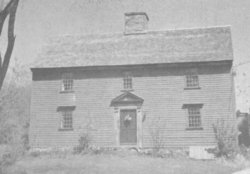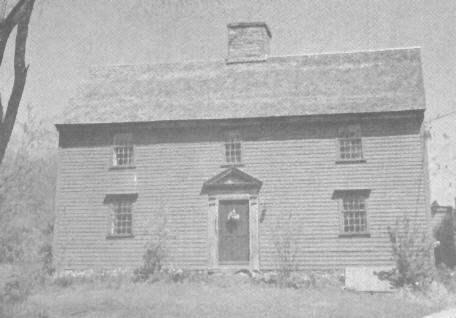Pelatiah was a large landholder and farmer. He kept 100 head of cattle and typically averaged 100 bushel of shelled corn per acre. He was a deacon in the Fourth Church of Guilford. He was often elected to represent the town in the General Court of the Colony.
He and his wife were married 1 July 1705. They lived together 63 years. Abigail died during a terrible epidemic that swept through Guilford taking 44 lives, including 7 Leetes, including 3 of her grandchildren (sons of her son Pelatiah) and her dau-in-law Rhoda (wife of Daniel).
Pelatiah and Abigail had five known children:
Abigail
Daniel
Mehitabel I
Pelatiah
Mehitabel II
This paragraph is taken from a 1981 official survey of Guilford report. Deacon Pelatiah Leete I was a successful farmer. He was the first settler of Leete’s Island, the land granted to Governor Leete in 1668-9. Leete built his first house on the south side of the road about 1705, according to Town records. (It was torn down in 1832-33.) This, his second house was built on the north side of the road about 1710, according to its current owner who cites soap stone inscriptions regarding corn crop records on the attic roof boards as supporting evidence of this date. On the other hand, Guilford Tax Records disclose a 54 pound increase, between 1744 and 1746, in taxes imposed on Pelatiah Leete I, suggesting his acquisition of this house during this period, i.e. about 1745. He died here in 1768. His grandson, Pelatiah III inherited the house in 1780. The Leetes owned the property until its sale in 1872. Thanks to careful restoration, this house gives an accurate sense of the original appearance of Guilford’s 18th century houses. Its connection with the area’s first settler as well as its architecture make this a singularly important house.
The following is from The Leete Legacy, a newsletter of the Leete Family Association, Vol III, No 1, Summer 1992, pp 5-6. This item was written in June 1989 by Priscilla Waters Norton. Rounded brackets ( ) are notes by Priscilla Waters Norton. Square bracket [ ] notes are those of this transcriber, Rev. J. Keith Cook in 2016.
“…Pelatiah came to Leete’s Island shortly after marrying Abigail Fowler in 1705 and built his house ‘where Edward L. Leete recently lived and resided there the remainder of his life.’ The crop marks in the attic make me wonder why his children grew up in this house if he was living in the house across the read all his life. [Notes: Perhaps “crop marks” used here refer to the growth heights markings of the children, rather than the usual printer’s trim markings.]
“I also wonder why the first house at Leete’s Island was built far from a fresh water brook, when there is one right outside this [newer] house. The earliest legible crop mark is 1732. There are marks suggestive of earlier dates. Many names are inscribed on the planks; Pelatiah (in two different signatures), Joel, Daniel, Noah - also childish drawings of sailing ships (all now under the insulation in the attic). Pelatiah II would have been 17 years old in 1730. He married ten years later at age 27. (I doubt this house was built by a teenaged boy).
“The house had its first modernization in 1766. We found the date on the lintel in the East room when we took out a brick fireplace which had been built inside the original stone fireplace. The fireplace we took out, the corner cupboards and the framing around the front (south) door all fit with the date 1766, whereas the size of the original fireplaces, lambs tongue chamfering and the way the windows were made, speaks to the late 17thy century - early 18tyh century.
“The house remained in the Leete family until 1930 when William S. Leete sold it to Dorothy Glen. Dorothy Glen sold it to me in 1950. Mrs. Glen and I really dedicated our lives to this home. For generations it has been ‘The Homestead’ surrounded by ‘The Farm.’ When we moved here in 1959 the land was open and actively farmed all around the house.
“Historically, the big events involving the house have been the births and deaths of many of the Leete family, such as Simeon. When they were blasting for the Railroad, a boulder came through the roof on the north side of the house and landed in the flour barrel. The corner cupboard in the west parlor was for many years the Leete’s Island Post Office. About the turn of the century one of the Leete ladies who taught at the Leete’s Island School, ran a lending library out that same cupboard!
“Since I have owned it, the house had become a favorite subject for articles on colonial architecture. It was among the first houses in Connecticut to be listed on the National Register of Historic Places, an honor I did not seek, but was proud to accept.” (PWN).
[The house has been updated to code, and physically restored, but with conscious faithfulness to the original.]
Pelatiah was a large landholder and farmer. He kept 100 head of cattle and typically averaged 100 bushel of shelled corn per acre. He was a deacon in the Fourth Church of Guilford. He was often elected to represent the town in the General Court of the Colony.
He and his wife were married 1 July 1705. They lived together 63 years. Abigail died during a terrible epidemic that swept through Guilford taking 44 lives, including 7 Leetes, including 3 of her grandchildren (sons of her son Pelatiah) and her dau-in-law Rhoda (wife of Daniel).
Pelatiah and Abigail had five known children:
Abigail
Daniel
Mehitabel I
Pelatiah
Mehitabel II
This paragraph is taken from a 1981 official survey of Guilford report. Deacon Pelatiah Leete I was a successful farmer. He was the first settler of Leete’s Island, the land granted to Governor Leete in 1668-9. Leete built his first house on the south side of the road about 1705, according to Town records. (It was torn down in 1832-33.) This, his second house was built on the north side of the road about 1710, according to its current owner who cites soap stone inscriptions regarding corn crop records on the attic roof boards as supporting evidence of this date. On the other hand, Guilford Tax Records disclose a 54 pound increase, between 1744 and 1746, in taxes imposed on Pelatiah Leete I, suggesting his acquisition of this house during this period, i.e. about 1745. He died here in 1768. His grandson, Pelatiah III inherited the house in 1780. The Leetes owned the property until its sale in 1872. Thanks to careful restoration, this house gives an accurate sense of the original appearance of Guilford’s 18th century houses. Its connection with the area’s first settler as well as its architecture make this a singularly important house.
The following is from The Leete Legacy, a newsletter of the Leete Family Association, Vol III, No 1, Summer 1992, pp 5-6. This item was written in June 1989 by Priscilla Waters Norton. Rounded brackets ( ) are notes by Priscilla Waters Norton. Square bracket [ ] notes are those of this transcriber, Rev. J. Keith Cook in 2016.
“…Pelatiah came to Leete’s Island shortly after marrying Abigail Fowler in 1705 and built his house ‘where Edward L. Leete recently lived and resided there the remainder of his life.’ The crop marks in the attic make me wonder why his children grew up in this house if he was living in the house across the read all his life. [Notes: Perhaps “crop marks” used here refer to the growth heights markings of the children, rather than the usual printer’s trim markings.]
“I also wonder why the first house at Leete’s Island was built far from a fresh water brook, when there is one right outside this [newer] house. The earliest legible crop mark is 1732. There are marks suggestive of earlier dates. Many names are inscribed on the planks; Pelatiah (in two different signatures), Joel, Daniel, Noah - also childish drawings of sailing ships (all now under the insulation in the attic). Pelatiah II would have been 17 years old in 1730. He married ten years later at age 27. (I doubt this house was built by a teenaged boy).
“The house had its first modernization in 1766. We found the date on the lintel in the East room when we took out a brick fireplace which had been built inside the original stone fireplace. The fireplace we took out, the corner cupboards and the framing around the front (south) door all fit with the date 1766, whereas the size of the original fireplaces, lambs tongue chamfering and the way the windows were made, speaks to the late 17thy century - early 18tyh century.
“The house remained in the Leete family until 1930 when William S. Leete sold it to Dorothy Glen. Dorothy Glen sold it to me in 1950. Mrs. Glen and I really dedicated our lives to this home. For generations it has been ‘The Homestead’ surrounded by ‘The Farm.’ When we moved here in 1959 the land was open and actively farmed all around the house.
“Historically, the big events involving the house have been the births and deaths of many of the Leete family, such as Simeon. When they were blasting for the Railroad, a boulder came through the roof on the north side of the house and landed in the flour barrel. The corner cupboard in the west parlor was for many years the Leete’s Island Post Office. About the turn of the century one of the Leete ladies who taught at the Leete’s Island School, ran a lending library out that same cupboard!
“Since I have owned it, the house had become a favorite subject for articles on colonial architecture. It was among the first houses in Connecticut to be listed on the National Register of Historic Places, an honor I did not seek, but was proud to accept.” (PWN).
[The house has been updated to code, and physically restored, but with conscious faithfulness to the original.]
Family Members
Advertisement
Advertisement







